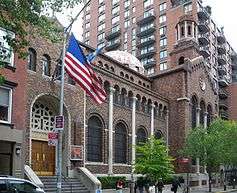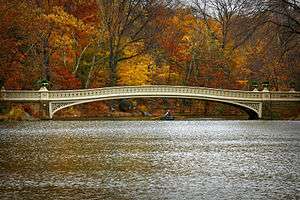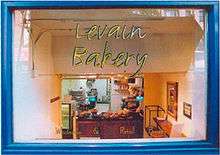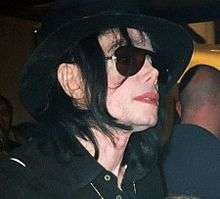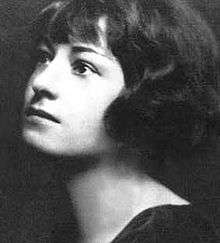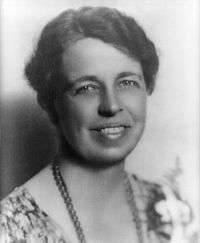74th Street (Manhattan)
Coordinates: 40°46′13″N 73°57′27″W / 40.770239°N 73.957393°W 74th Street is an east-west street carrying pedestrian traffic and eastbound automotive/bicycle traffic in the New York City borough of Manhattan. It runs through the neighborhoods of the Upper East Side (in ZIP code 10021, where it is known as East 74th Street) and the Upper West Side (in ZIP code 10023, where it is known as West 74th Street), on both sides of Central Park.
History
In 1639, Colony's Sawmill stood at the corner of East 74th Street and Second Avenue, in the Dutch village of New Amsterdam, at which African laborers cut lumber.[1][2]
In 1664, the English took over Manhattan and the Dutch colony of New Amsterdam from the Dutch. English colonial Governor Richard Nicolls made 74th Street, beginning at the East River, the southern border patent line (which was called the "Harlem Line") of the village of Nieuw Haarlem (later, the village of Harlem); the British also renamed the village "Lancaster".[3][4][5][6]
That same year Jan van Bonnel built a saw mill on East 74th Street and the East River, where a 13,710-meter long creek or stream that began in the north of today’s Central Park, which became known as the Saw Kill or Saw Kill Creek, emptied into the river.[7][8][9][10][11] Later owners of the property George Elphinstone and Abraham Shotwell replaced the sawmill with a leather mill in 1677.[7][12] The Saw Kill Bridge was built, and since at least 1806 was known as "The Kissing Bridge" because its surrounding beautiful landscape and seclusion made it a favorite spot to kiss in 18th and 19th century Manhattan.[7]
East 74th Street between Fourth Avenue (now Park Avenue) and Fifth Avenue was the northern boundary of a 30-acre (120,000 m2) farm known as the "Lenox Farm" created by pieces of land that Robert Lenox purchased in 1818; the area later became known as Lenox Hill.[13]
Frederick Ambrose Clark developed a good portion of West 74th Street in 1902–04.[14]
In 1938, an open-air market on East 74th Street, east of Second Avenue, was supplanted with an enclosed market.[15]
Transportation
The closest subway stops for East 74th Street on the Upper East Side are the 68th and 77th Street stations (6 <6> trains during the day and 4 6 trains during the night) of the IRT Lexington Avenue Line. The 72nd Street station on Second Avenue is a planned station that is under construction, as part of the new Second Avenue Subway, and is scheduled to open in December 2016 on the Q train.[16]
The closest subway stops for West 74th Street on the Upper West Side are the IRT Broadway – Seventh Avenue Line (1 2 3 trains) that run along Broadway making stops at 72nd and 79th Streets,[17] and the IND Eighth Avenue Line (A B C trains) that run along Central Park West stopping at 72nd and 81st Streets.
Notable places
East Side
- 927 Fifth Avenue, at Fifth Avenue at the southeast corner of East 74th Street, upscale 12-story limestone-clad 1917 residential apartment building in the Renaissance Revival style.
- 930 Fifth Avenue, at Fifth Avenue at the northeast corner of East 74th Street, luxury 18-story 1940 apartment building.[18]
- Consulate General of France Annex, at 10 East 74th Street[19]
- Caravaggio, Italian restaurant, at 23 East 74th Street; in 2013, Zagats gave it a food rating of 26, the fourth-best in the East 70s.[20]
- Mallett Antiques, at 929 Madison Avenue and East 74th Street, antique dealer.
- Stable Gallery, at 33 East 74th Street, founded in 1953, hosted early solo New York exhibitions for artists including Robert Indiana and Andy Warhol.
- Côte d'Ivoire Permanent Mission to the United Nations, at 46 East 74th Street.[21]
- Church of the Resurrection, at 119 East 74th Street, 1869 Gothic Revival parish of the Episcopal Diocese of New York in the Episcopal Church.[22]
- Mannes College of Music, at 157 East 74th Street.[23]
- J.G. Melon, at 1291 Third Avenue on the north-east corner of East 74th Street, hamburger restaurant.[24] where a scene for the Academy Award-winning movie Kramer vs. Kramer was filmed with Dustin Hoffman and Meryl Streep.
- Casa 74, at 255 East 74th Street, 30-story, 87-apartment condominium building.
- Archdiocesan Cathedral of the Holy Trinity, at 319–337 East 74th Street, 1931 Byzantine Moderne-style Greek Orthodox church that serves as the national cathedral of the Greek Orthodox Archdiocese of America and Archbishop Demetrios of America.[22]
- The Forum at 343 East 74th Street, a 25-story residential condop building completed in 1986.
- Jan Hus Presbyterian Church, at 351 East 74th Street, 1880 Bohemian Gothic Revival Presbyterian church.[22]
- Church of the Epiphany, at 1393 York Avenue on the northwest corner of East 74th Street, 1939 Episcopal church designed in the Norman Gothic style.
- 74th Street Power Station, across York Avenue from the church, built in 1901 to electrify the Elevated railroads of Manhattan.[25]
Central Park
- In Central Park near East 74th Street: Loeb Boathouse and the Boathouse Cafe, Kerbs Boathouse and Conservatory Water (the sailboat pond), and north of it a larger-than-life bronze statue of Alice, sitting on a huge mushroom, playing with her cat, while the Mad Hatter and the March Hare look on; just west of the model boathouse there is a statue of Hans Christian Andersen holding an open book, with the diminutive hero of The Ugly Duckling in front of him, and Bow Bridge.[26][27]
West Side
- The Langham, 135 Central Park West between West 73rd Street and West 74th Streets, 1907 apartment building in the French Second Empire style.
- The San Remo, 145 and 146 Central Park West between West 74th Street and West 75th Street, luxury 27-floor co-operative apartment building.
- Calhoun School, at 160 West 74th Street, independent, coeducational college preparatory school founded in 1896.
- De La Salle Institute, at 160–62 West 74th Street, former Catholic Church school for boys.
- Levain Bakery, at 167 West 74th Street.
- The Ansonia, at 2109 Broadway between West 73rd and West 74th Streets, 1899 building originally built as a hotel.
- The Beacon Theatre, at 2124 Broadway at West 74th Street, a 2,894-seat, three-tiered theatre built in 1929.
Notable residents
East Side
- John Vernou Bouvier III, American socialite, Wall Street stockbroker, and father of Jacqueline Kennedy Onassis and Lee Radziwill, at 125 East 74th Street.[28]
- Yul Brynner, actor, rented 151 East 74th Street[29]
- Marc Chagall, artist, at 4 East 74th Street.[30]
- Walker Evans, photographer, at 112 East 74th Street.[31]
- Henry Fonda, actor, at 151 East 74th Street[29][32]
- John Giorno, poet and performance artist, at 255 East 74th Street.[33]
- Charles Ives, modernist composer, at 164 East 74th Street.[34]
- Michael Jackson, singer-songwriter, entertainer, dancer, arranger, music producer, choreographer, actor, businessman, and musician, at 4 East 74th Street.[30]
- Marc Lasry, billionaire hedge fund manager, 4 East 74th Street.[35]
- Myrna Loy, actress, at 23 East 74th Street.[36]
- Andrew Madoff, stockbroker and investment advisor, at 433 East 74th Street.[37][38]
- Jacqueline Kennedy Onassis, wife of President John F. Kennedy and Greek shipping magnate Aristotle Onassis, at 125 East 74th Street.[39][40][41]
- Pale Male, well-known Red-tailed Hawk, at 927 Fifth Avenue at East 74th Street.
- Dorothy Parker, poet, short story writer, critic, and satirist, at 23 East 74th Street.[34]
- Eleanor Roosevelt, the longest-serving First Lady of the United States, at 55 East 74th Street.[34]
- Harry Slatkin, businessman, entrepreneur, and philanthropist, at 18 East 74th Street.[42]
- Kenneth I. Starr, money manager, at 433 East 74th Street.[43]
- Arthur Ochs Sulzberger, publisher and businessman.[44]
- Arthur Ochs Sulzberger, Jr., publisher.[44]
- Woody Allen, director, actor, author, playwright, at 930 Fifth Ave. at 74th Street.[45][46]
West Side
- Harry Belafonte, 21-room apartment at 300 West End Avenue on the corner of West 74th Street, singer, songwriter, actor and social activist.
- Jean Xceron, at 47 West 74th Street, abstract painter.[47]
- Theresa Bernstein, at 54 West 74th Street, artist, painter, and writer.
- Ernie Kovacs, comedian, actor, and writer.
- Emma Marcy Raymond, at the Ansonia, composer of operetta, songs and piano music.
- Joe Sinnott, at Broadway and West 74th Street, comic book artist.
References
- ↑ Michael T. Martin; Marilyn Yaquinto (2007). Redress for Historical Injustices in the United States: On Reparations for Slavery, Jim Crow, and Their Legacies. Duke University Press. p. .
- ↑ Howard Dodson; Christopher Moore; Roberta Yancy; Schomburg Center for Research in Black Culture (2000). The Black New Yorkers: the Schomburg illustrated chronology. John Wiley. p. .
- ↑ Elliot Willensky; Fran Leadon (2010). AIA Guide to New York City. Oxford University Press. p. .
- ↑ Eric K. Washington (2012). Manhattanville: Old Heart of West Harlem. Arcadia Publishing. p. .
- ↑ James Renner (2007). Washington Heights, Inwood, and Marble Hill. Arcadia Publishing. p. .
- ↑ "Mount Morris Bank Building" (PDF). Landmarks Preservation Committee. January 5, 1993. Retrieved April 10, 2013.
- 1 2 3 "The saw-kill and the making of dutch colonial Manhattan: Sawkill Lumber Co". Sawkil.com. Retrieved April 14, 2013.
- ↑ Arthur Bunyan Caldwell (1882). The History of Harlem: An Historical Narrative Delivered at Harlem Music Hall, April 24th, 1882: a Lecture. Small Talk Publishing Company. p. .
- ↑ Social studies. 1962. p. .
- ↑ Carl Horton Pierce; William Pennington Toler; Harmon De Pau Nutting (1903). New Harlem Past and Present: The Story of an Amazing Civic Wrong, Now at Last to be Righted. New Harlem Publishing Company. p. .
- ↑ History and commerce of New York, 1891. American Publishing and Engraving Co. 1891. p. .
- ↑ Anthony Lofaso (2010). Origins and History of the Village of Yorkville in the City of New York. p. .
- ↑ Kenneth T. Jackson; Lisa Keller; Nancy Flood (2010). The Encyclopedia of New York City (Second ed.). Yale University Press. p. .
- ↑ Andrew S. Dolkart (2008). Guide to New York City Landmarks. John Wiley & Son. p. .
- ↑ New York (N.Y.). City Planning Commission (1938). Major Reports of the City Planning Commission. p. .
- ↑ Peter Donohue (January 30, 2013). "Second Ave. subway on track to open in 2016: MTA". NY Daily News. Retrieved April 13, 2013.
- ↑ "info". mta.info. Retrieved April 11, 2013.
- ↑ "20-STORY BUILDING ON 5TH AVE. SOLD – Uris Disposes of 74th Street Corner-$650,000 Holding on E. 46th Changes Hands Second Ave. Corner Bought Deal on East 75th Street Madison Ave. Building Sold 2 Apartments Change Hands". New York Times. January 30, 1957. Retrieved April 11, 2013.
- ↑ "CONSULATE GENERAL OF FRANCE ANNEX, NEW YORK, 10 EAST 74TH STREET". Cylex-usa.com. Retrieved April 10, 2013.
- ↑ Caravaggio | Manhattan | Restaurant Menus and Reviews. Zagat. Retrieved April 11, 2013.
- ↑ Taylor & Francis Group (2004). Europa World Year. Taylor & Francis. p. .
- 1 2 3 Elliot Willensky; Fran Leadon (2010). AIA Guide to New York City. Oxford University Press. p. .
- ↑ "Music & Dance". New York Magazine: . May 17, 1982.
- ↑ J.G. Melon | Manhattan | Restaurant Menus and Reviews. Zagat. 2013. Retrieved April 11, 2013.
- ↑ Construction of the 74th Street Power Station, nycblog.org
- ↑ Jack R. Finnegan (2007). Newcomer's Handbook For Moving to and Living in New York City: Including Manhattan, Brooklyn, the Bronx, Queens, Staten Island, and Northern New Jersey. First Books. p. .
- ↑ "The Official Website of Central Park". centralparknyc.org. Retrieved April 11, 2013.
- ↑ Edward Klein (1997). All Too Human: The Love Story of Jack and Jackie Kennedy. Simon and Schuster. p. .
- 1 2 Kiley Armstrong (August 1, 1986). "Maps Now Help Fans Swoon Near Stars' New York Homes". Apnewsarchive.com. Retrieved April 10, 2013.
- 1 2 Tracie Rozhon (November 16, 2000). "BIG DEAL; An Old Chagall Haunt, Repainted". New York Times. Retrieved April 10, 2013.
- ↑ Belinda Rathbone (2000). Walker Evans: A Biography. Houghton Mifflin Harcourt. p. .
- ↑ "page 9". Atchison Daily Globe. March 10, 1957. Retrieved April 10, 2013.
- ↑ Kenneth Goldsmith (2004). I'll Be Your Mirror: The Selected Andy Warhol Interviews: 1962–1987. Da Capo Press. p. .
- 1 2 3 James Malanowski (July 17, 1959). "Dead & Famous; Where the Grim Reaper has Walked in New York". Spy: .
- ↑ "Manhattan real estate news, data and statistics, home sales and real estate listings | Manhattan". Manhattan.blockshopper.com. Retrieved April 10, 2013.
- ↑ Emily W. Leider (2011). Myrna Loy: The Only Good Girl in Hollywood. University of California Press. p. .
- ↑ Sara Polsky (March 28, 2013). "Andrew Madoff; Where Financial Fraudsters Have Lived in New York City". Curbed NY. Retrieved April 10, 2013.
- ↑ Vanity Fair; Graydon Carter (2010). "The Great Hangover: 21 Tales of the New Recession from the Pages of Vanity Fair". HarperCollins: .
- ↑ John H. Davis (1998). Jacqueline Bouvier: An Intimate Memoir. John Wiley & Sons. p. .
- ↑ Stephen Birmingham (1979). Jacqueline Bouvier Kennedy Onassis. Pocket Books. p. .
- ↑ Sarah Bradford (2001). America's Queen: The Life of Jacqueline Kennedy Onassis. Penguin. p. .
- ↑ "The Real Estalker: Another $95 Million Manhattan Spread Up for Grabs". Realestalker.blogspot.com. September 24, 2012. Retrieved April 10, 2013.
- ↑ Sara Polsky (March 28, 2013). "Where Financial Fraudsters Have Lived in New York City – Scandalous Real Estate". Curbed NY. Retrieved April 10, 2013.
- 1 2 Edwin Diamond (1995). Behind the Times: Inside the New New York Times. University of Chicago Press. p. .
- ↑ New York: the movie lover's guide: the ultimate insider tour of movie New York, Richard Alleman, Random House, Inc., 2005, p. 188
- ↑ Kelly, Kate (July 25, 1999). "Woody Allen's Fifth Avenue Co-op Up for Grabs for $15 Million". New York Observer.
- ↑ "Jean Xceron Dies Here at 77 - Pioneer in Nonobjective Art - Acclaimed in Paris in 1931 at First Show On Staff of Guggenheim Museum". New York Times. June 10, 2012. Retrieved April 22, 2013.
External links
- Early Days at the 74th Street Power Plant Site: The Story of 300 Years, Susan Elizabeth Lyman (1951)
- Photographs of Kienbusch Mansion, 12 East 74th Street, New York City, Carl Otto von Kienbusch (Collection)
| Wikimedia Commons has media related to 74th Street (Manhattan). |

